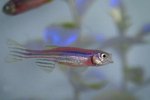Ghost knife fish (Apteronotus albifrons) rarely breed in captivity. This is largely related to their size -- large specimens may reach 20 inches in length -- but the species' temperament also produces challenges: Ghost knife fish often display aggression toward conspecifics kept in the same tank, making pairing difficult. Occasionally, aquarium enthusiasts can solicit spawning behavior and find fry lurking in the bottom of their tanks.
Indonesian Success
Fish farms in Indonesia began successfully breeding ghost knife fish in the early 2000s. Most of these farms guard their breeding secrets and provide few details about their protocols. Nevertheless, the success of these farms has reduced the pressure on wild populations, and farm-bred specimens now populate aquarium store tanks instead of wild-caught ones. Many speculate that these farms succeed by employing extraordinarily large breeding ponds and administering hormones to the fish, two techniques that are difficult or impossible for hobbyists to replicate.
Tank Size
The first mistake many would-be ghost knife fish breeders make is keeping their fish in unsuitable aquariums. A single ghost knife fish needs a minimum of 100 gallons of space; 125 gallons is better. To breed fish of this species, you will need an aquarium with a capacity of 200 gallons or more.
Tank Setup
Healthy specimens are imperative for successful spawning. Accordingly, you must set up your tank correctly to ensure that your knife fish remain healthy and stress-free. Use a fine-grain substrate, such as sand or gravel, on the bottom of the tank, and add plenty of driftwood and plants to the tank to provide visual barriers and hiding spots. Many knife fish keepers place “ghost tubes” in their tanks. Because ghost fish have poor eyesight, so they rely on an electricity-based navigation system to find hiding places -- the clear tubes allow the fish to feel safe while remaining visible to the hobbyist.
Introducing Pairs
Ghost knife fish lack obvious external differences between the sexes, which makes it difficult to establish a pair. While researchers at the University of Indiana have discovered differences in the electrical signals produced by male and female knife fish, this is of little help to hobbyists. Males often exhibit red colors on their tails, but generally only during spawning season. As same-sex pairs will fight savagely, introducing specimens courts disaster. Even properly sexed pairs can be incompatible, so hobbyists can do little but observe newly paired fish closely and separate them if signs of aggression manifest. Some aquarists have had success raising small groups of ghost fish together in very large tanks, which may help reduce conflict and raises the chances of achieving at least one pair.
Inducing Spawning
Few stimuli reliably induce spawning behavior in knife fish, but Mongabay.com reports that simulating a rainy season may elicit spawning behavior. Spawning occurs during the night, so hobbyists often miss the act but find eggs on the bottom of the tank. Be sure to include plenty of submerged plants, which serve as egg deposition sites. The eggs typically hatch within a week of spawning.
Caring for the Fry
The adults will eat the fry, so move the young fish to a separate tank. The young are carnivorous, so feed them an assortment of small worms and pellets. Be sure to feed the young after dark, as they may be reluctant to eat during the day.
References
- Badman's Tropical Fish: Black Ghost Knife Fish
- Aquarium Industries: Black Ghost Knife Fish
- Animal-World: Black Ghost Knifefish
- Mongabay.com: Knifefish
- Tropical Fish Hobbyist: Fish of the Month: Apteronotus Albifrons
- Aquatic Community: Clown Knife Fish - Chitala Ornata
- Indiana University: Learn About Electric Fish
Photo Credits
-
kizilkayaphotos/iStock/Getty Images



